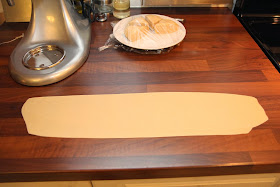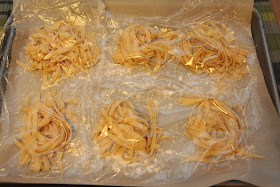
I'm definitely in Christmas prep mode so it's been hard to find a moment to share this wonderful recipe but recently I made it when friends came over as a cozy supper to start off the holiday season. I feel that it's a wonderful option for those who are thinking of making a memorable and comforting holiday meal. This is definitely one of those special occasion recipes because it does require a bit of time to make but the results are worth it. Plus this is one of those recipes that you can say was made with "love" because I think that's just another way of saying made with patience!
I tend to make this favourite Bolognese recipe whenever I'm in need of a nice meat sauce but this Ragu alla Bolognese really the ultimate Bolognese recipe because it requires multiple meats and no tomato sauce (only tomato paste)! So the meaty flavour is really amplified. I'm particularly fond of the fresh egg pasta because of it's texture. Dried pasta does not stand a chance next to fresh pasta! This is one of my boyfriend's favourite dishes so I'm happy to have it in my repertoire.
Note: This does require the use of a pasta machine but I'm so glad I got one last Christmas because I can't believe I made it that long without tasting my own fresh egg pasta!! The one that I received is from Kitchen Aid and it attaches to my stand mixer. I've already tried using pasta machines that you crank by hand and those work fine as well.
I started off by browning my meat once other ingredients were prepped.
I had used my food processor (it will get used 3 times in this recipe) to finely dice the mirepoix (onion, carrot, and celery).
I also used the food processor to finely chop up my pancetta and mortadella.
Ingredients were added into the pot and at this stage I had just added in the wine to loosen up the fond.
After the sauce simmered for 1 1/2 it resembled a deep rust colour.
Meanwhile, as the sauce was simmering away, I used the food processor to blend eggs and flour for the pasta.
I made sure that there was enough moisture in the dough so that it would form small pebbles but clump together if pinched.
After kneading the dough fro a couple of minutes it smoothed out a lot.
I let the dough rest and then divided it into 6 pieces.
Using one piece at a time I ran it twice though the setting 1 (the widest setting).
I then folded it over itself and pressed it together then passed it again twice through setting 1, this time with the folded edge first.
This helps the dough form into a more "rectangular" looking piece and it slowly starts thinning the pasta sheets.
I repeated the process passing though each setting twice and then I stopped after passing it twice through setting 5. My pasta maker instructions recommend setting 5 for fettuccine cut which was what I was going for. Remember to always pass the pasta in ascending order and if ever there's a mistake just press the dough together and start over.
The final stage would be to run the pasta sheet through the wide cutter, approximately 1/8 to 1/4 inch thickness.
Just lovely!
I then spread the cut pasta on a floured baking sheet and covered it in plastic wrap in order to avoid it from drying out. I would recommend making sure that the noodles aren't clumped together so it's better to bundle it as I did it in the top left corner of the above image. All that is left is to boil the pasta and check for it's doneness. Nearly ever recipe says that fresh pasta cooks up in less time but personally I prefer to have my fresh pasta well cooked as opposed to al dente. I prefer the al dente for dried pasta. But do it to your liking and enjoy!
Ragu alla Bolognese
Yield: Makes about 6 cups, enough to coat 2 pounds of pasta.
NB: Leftover sauce may be refrigerated for up to three days or frozen for up to one month. Eight teaspoons of gelatin is equivalent to one (1-ounce) box of gelatine. If you can't fine ground veal, use and additional 3/4 pound of ground beef.
Ingredients
1 cup low-sodium chicken broth
1 cup beef broth
8 teaspoons unflavoured gelatin
1 onion, chopped coarse
1 large carrot, peeled and chopped coarse
1 celery rib, chopped coarse
5 ounces pancetta, chopped fine (I used 150g)
6 ounces mortadella, chopped (I used 175g)
3 tablespoons extra-virgin olive oil
3/4 pound 85 percent lean ground beef
3/4 pound ground veal
3/4 pound ground pork
1 tablespoons minced fresh thyme
1 tablespoons minced fresh rosemary
3 cloves of garlic, finely chopped
1 (6-ounce) can tomato paste
2 cups dry red wine
Salt and pepper
1 pound of pappardelle, tagliatelle or fresh pasta (see recipe below)
Parmesan cheese, grated, for serving
Combine chicken broth and beef broth in bowl; sprinkle gelatin over top and set aside. Pulse onion, carrot, and celery in food processor until finely chopped, about 10 pulses, scraping down bowl as needed; transfer to separate bowl. Pulse pancetta and mortadella in now-empty food processor until finely chopped, about 25 pulses, scraping down bowl as needed; transfer to second bowl.
Heat oil in large Dutch oven over medium-high heat until shimmering. Add beef, veal, and pork; cook, breaking up pieces with spoon, until all liquid has evaporated and meat begins to sizzle, 10 to 15 minutes. Add chopped pancetta mixture and herbs; cook, stirring frequently, until pancetta is translucent, 5 to 7 minutes, adjusting heat to keep fond from burning. Add chopped vegetables and cook, stirring frequently, until softened, 5 to 7 minutes. Add garlic and cook until fragrant, about 30 seconds. Add tomato paste and cook, stirring constantly, until rust-coloured and fragrant, about 3 minutes.
Stir in wine, scraping pan with wooden spoon to loosen fond. Simmer until sauce has thickened, about 5 minutes. Stir in broth mixture and return to simmer. Reduce heat to low and cook at bare simmer until thickened (wooden spoon should leave trail when dragged through sauce), about 1 1/2 hours. Season with salt and pepper to taste; cover and keep warm.
Bring 4 quarts water to boil in large pot. Add pasta and 1 tablespoon salt and cook, stirring occasionally, until al dente (or desired doneness). Reserve 3/4 cup cooking water, then drain pasta and return it to pot. Add half of sauce and cooking water to pasta and toss to combine. Transfer to serving bowl and serve, passing cheese separately.
Source: adapted from Cook's Illustrated
Fresh Egg Pasta
Yield: about 1 pound pasta
NB: Depending on the weather and the flour, this dough may or may not require water. But don't fret over the decision- it is quite easy to tell either way.
Ingredients
2 cups all-purpose flour, plus extra as needed
3 large eggs, beaten
Water
Pulse the flour a few times in a food processor to aerate. Add the eggs and process until the dough forms a rough ball, about 30 seconds.
If the dough resembles small pebbles, add water, 1/2 teaspoon at a time. If the dough sticks to the sides of the work bowl, add flour, 1 tablespoon at a time, and process until the dough forms a rough ball.
Turn out the dough ball and any small bits onto a clean counter. Knead the dough by hand until it is smooth, about 2 minutes. Cover with plastic wrap and let rest for 15 minutes (or up to 2 hours) before rolling.
Cut about one-sixth of the dough from the ball and flatten it into a disk. (Re-cover the remaining dough with plastic warp.) Run the disk through rollers set to the widest setting on the pasta machine. Bring the ends of the dough towards the middle and press down to seal. Feed the open side of the sheet of pasta dough through the rollers. Re-roll the dough twice. Without folding it again, run the pasta dough through the widest setting twice, or until the dough is smooth. If the dough is at all sticky, dust it lightly with flour. Roll the dough thinner by putting it through the machine repeatedly, narrowing the setting each time. Roll the dough until it is thin and satiny. You should be able to see the outline of your hand through the sheet of pasta. Lay the sheet on a clean kitchen towel and cover it with a damp cloth to keep it from drying out. Repeat with the remaining dough, one piece at a time.
Run each sheet of pasta through the wide cutter on the pasta machine. Each noodle will measure 1/8 to 1/4 inch across. To keep the fettuccine from sticking together, spread it out on a floured baking sheet until you are ready to cook it.
Source: America's Test Kitchen Family Cookbook
















No comments:
Post a Comment